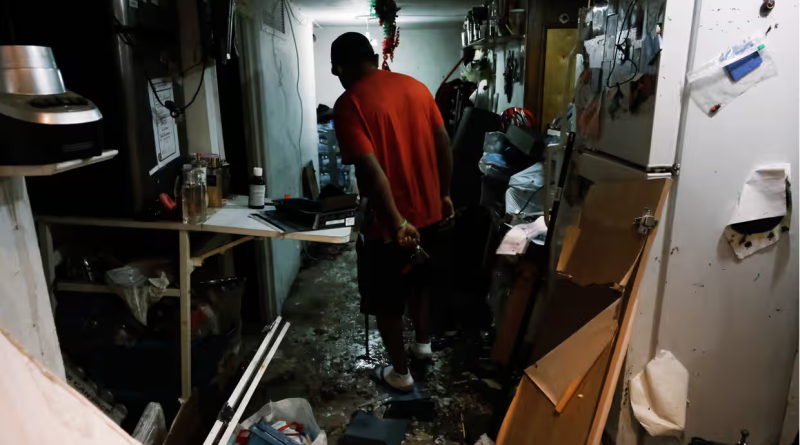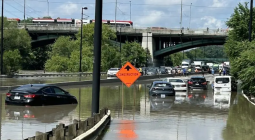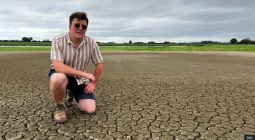‘I panic when I hear rain’: New York’s deadly basement apartments face growing flooding risk

A man walks through his flooded basement-level apartment in Queens after Hurricane Ida, on 3 September 2021 in New York City. Photograph: Spencer Platt/Getty Images
Josh Alba had lived in an illegal basement apartment in Queens, New York, for almost five years. Despite the low ceilings, he savored his chance to afford housing without roommates. But his tenure there ended during Hurricane Ida.
He’d been asleep on his couch as the rain started falling. He only woke up when his cat smacked him in the face, and he noticed water coming in from outside, rising to at least an inch on the floor.
Alba wrapped his cat in a blanket and texted his landlord, who unlocked the door to upstairs through which he escaped. Later, he said, the water broke down the door leading outside from the basement, and the floods came up to about 5ft, toppling the refrigerator and ruining most of his belongings.
“I could’ve died if I didn’t wake up,” he said. Now 35, Alba lives in Bushwick, Brooklyn, with roommates, paying just $300 less for his room than he had paid for his former basement apartment.
In September 2021, Hurricane Ida deluged New York City with floodwaters and record rainfall – and killed 13 New Yorkers, including 11 who drowned in basement homes.
n addition to those who died in Ida’s floods, hundreds more, like Alba, found themselves displaced after flooding rendered their living quarters uninhabitable, and homeowners struggled to make repairs.
The tragedy highlighted the flood danger of the underground dwellings – estimated at about 100,000 in 2008 – and supercharged a movement to make basements a safer housing option. On the third anniversary of the hurricane, experts say progress is just beginning.
Many basement apartments are illegal and do not conform to codes: they may have low ceilings and lack full windows or means of egress, making them a hazard for fires and, as Hurricane Ida demonstrated, deadly flooding.
“Those apartments are in a very special position where they are affordable, but that affordability comes at a very steep price during intense rain,” said Yana Kucheva, a City College of New York sociology professor who studies housing and environmental justice.
During Ida, some locations recorded as much as 3in of rain within a single hour – a preview of what the area can expect thanks to a warming planet. New York City is predicted to see as much as 10% more rain in the next decade, and about 1.5 times as many days with more than an inch of rain, according to climate science commissioned by the city government.
More than 4,000 basement units house lower-income renters in areas at risk of major flooding, according to a report by the Federal Reserve Bank of New York.
Legalizing basements by getting them up to code, some say, could help prevent residents from getting stuck in the event of floods and fires. Plus, tenant advocates argue that bringing illicit living spaces into the legal light will also give basement dwellers legal protections and allow them to report unsafe conditions.
But upgrading basements on a large scale could be many years away, and the logistical and financial feasibility of doing so remains a question, as a 2019 pilot program showed. The pilot aimed to convert 40 basements in one part of East New York, Brooklyn, but – stymied by rules that required costly renovations – resulted in just one conversion. It could cost almost $14bn to convert 50,000 illegal units, the city estimated.
A proposal by the administration of Mayor Eric Adams seeks to alter some of those zoning rules that made it all but impossible for homeowners to upgrade their basements into legal apartments.
And a new state program approved as a compromise allows legal basement apartments in 15 areas of the city, though they are not where the most units are located.
These proposals were “groundbreaking” and represented “major progress” in the past three years, said Annetta Seecharran, executive director at Chhaya, a non-profit group focused on the south Asian and Indo-Caribbean communities in Queens. It is a member of the Basement Apartments Safe for Everyone (Base) coalition, which has for 15 years pushed to legalize basement dwellings.
But material conditions for basement tenants have been largely the same since Ida, Seecharran said, through communication and outreach to tenants and homeowners have ramped up.
Early warnings
Four months after Ida, Adams became mayor, and laid out how the city government would prepare for storms and called on residents to take action. The department of environmental protection distributed to residents hundreds of packages containing sump pumps, flood barriers and flood alarms that indicate when water is rising.
“Just as we would never have a home that doesn’t have a smoke alarm, a basement apartment really needs to have that audio indicator when there is water accumulating, so that it doesn’t catch you unaware,” said Rohit Aggarwala, the department’s commissioner.
The Adams administration also committed to conducting community outreach to warn basement residents of possible flooding before heavy rainfall. This summer, the agency flew drones outfitted with loudspeakers over flood-prone neighborhoods before severe rainstorms to warn residents.
The city’s emergency management agency began to send out warnings about flash floods and heavy rains before those events. About 1.2 million New Yorkers – approximately an eighth of the city’s population – subscribe to those notifications. A new list created especially for basement residents has more than 5,000 subscribers, according to the agency.
Though the emergency notifications are available in more than a dozen languages, New Yorkers – especially Queens residents, where most basement apartments are known to be located – speak hundreds of languages. In documents submitted to the federal government after Ida, the city admitted that communicating only in English and Spanish was a shortfall during Ida, especially since 40% to 80% of households in neighborhoods where deaths occurred spoke other languages.
The emergency management agency plans to undertake a study in order to improve communication and evacuation strategies for those living in basement apartments and those who are non-English speakers.
In many cases, tenants and neighbors may not subscribe to notifications but keep an eye on the weather forecast and look out for one another. Take one homeowner of a small brick row house in East Elmhurst, Queens, who fixed up her basement for her 92-year-old mother to live in so she could have her own space but be close by.
She estimated Hurricane Ida brought about 7ft of water into the apartment, and her mother retreated into the above-ground area of the house. After the basement was repaired, her mother moved back, in spite of her daughter’s pleas.
“When old people have something in their mind, it’s so hard for you to change,” the homeowner said. “I tried to convince my mom: ‘Can you please come upstairs, and that would be better, then we wouldn’t be so afraid.’ But she refused.”
The homeowner said that when she immigrated from the Dominican Republic, she figured New York City was safe from floods and hurricanes. Now she knows better.
“To be honest, I don’t like thinking about it … Even right now, I panic when I hear the word ‘rain’,” she said. “When they’re expecting rain in the night-time, me and my husband are awake.”





